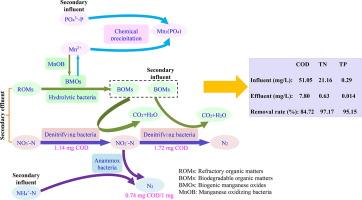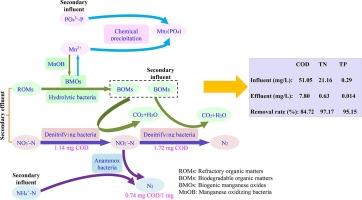Advanced C, N and P removal performance and mechanism of municipal wastewater in lab-scale denitrifying filter for generating biogenic manganese oxides
IF 9
1区 工程技术
Q1 ENGINEERING, CHEMICAL
引用次数: 0
Abstract
In order to cost-effectively remove carbon (C), nitrogen (N) and phosphorus (P) from secondary effluent (SE), a lab-scale denitrifying filter (DF) for generating biogenic manganese oxides (BMOs) was constructed, and its influent was the mixture of real SE and secondary influent (SI). When NH4+-N in the influent rose to around 3.2 mg/L with the improvement of the SI ratio, the effluent COD, filtered total nitrogen (TN) and phosphorus (TP) were 7.80, 0.63 and 0.014 mg/L with the corresponding removal rate (CRR) of 84.72 %, 97.17 % and 95.15 %, respectively. The refractory organics were oxidized and hydrolyzed to biodegradable organics, providing carbon source, and the residual organics were hardly further removed, owing to their extremely poor biodegradability. N was synergistically removed by denitrification coupled with partial-denitrification anammox (PDA), which was confirmed by the fact that the contribution rate of PDA to TN removal was 30.43 % and removing 1 mg TN actually consumed 2.02 mg COD. P was mainly removed by reacting with Mn2+ from the influent or BMOs reduction to form chemical precipitation (Mn3(PO4)2). The presence of the main functional bacteria (manganese oxidizing bacteria (MnOB), anammox, denitrifying and hydrolytic bacteria) and the main functional genes further explained the efficient C, N and P removal and clarified the advanced C, N and P removal mechanism. This novel technique removed C, N and P with extremely high efficiency, extremely low operational cost and no secondary pollution.


生物氧化锰反硝化滤池对城市污水C、N、P的深度去除效果及机理研究
为了经济有效地去除二级出水(SE)中的碳(C)、氮(N)和磷(P),构建了一个实验室规模的反硝化过滤器(DF),用于生成生物锰氧化物(BMOs),其进水为真实SE和二级出水(SI)的混合物。随着SI比的提高,进水NH4+-N升至3.2 mg/L左右时,出水COD、过滤总氮(TN)和磷(TP)分别为7.80、0.63和0.014 mg/L,相应的CRR分别为84.72 %、97.17 %和95.15 %。难降解的有机物被氧化水解为可生物降解的有机物,提供了碳源,而残留的有机物由于其可生物降解性极差,很难被进一步去除。反硝化与部分反硝化厌氧氨氧化(PDA)协同去除N, PDA对TN去除的贡献率为30.43 %,去除1 mg TN实际消耗COD为2.02 mg。P主要通过与进水中的Mn2+反应或BMOs还原形成化学沉淀(Mn3(PO4)2)来去除。主要功能菌(锰氧化菌(MnOB)、厌氧氨氧化菌、反硝化菌和水解菌)和主要功能基因的存在进一步解释了高效去除C、N、P,阐明了先进的C、N、P去除机理。该技术除碳、氮、磷效率极高,运行成本极低,无二次污染。
本文章由计算机程序翻译,如有差异,请以英文原文为准。
求助全文
约1分钟内获得全文
求助全文
来源期刊

Separation and Purification Technology
工程技术-工程:化工
CiteScore
14.00
自引率
12.80%
发文量
2347
审稿时长
43 days
期刊介绍:
Separation and Purification Technology is a premier journal committed to sharing innovative methods for separation and purification in chemical and environmental engineering, encompassing both homogeneous solutions and heterogeneous mixtures. Our scope includes the separation and/or purification of liquids, vapors, and gases, as well as carbon capture and separation techniques. However, it's important to note that methods solely intended for analytical purposes are not within the scope of the journal. Additionally, disciplines such as soil science, polymer science, and metallurgy fall outside the purview of Separation and Purification Technology. Join us in advancing the field of separation and purification methods for sustainable solutions in chemical and environmental engineering.
 求助内容:
求助内容: 应助结果提醒方式:
应助结果提醒方式:


